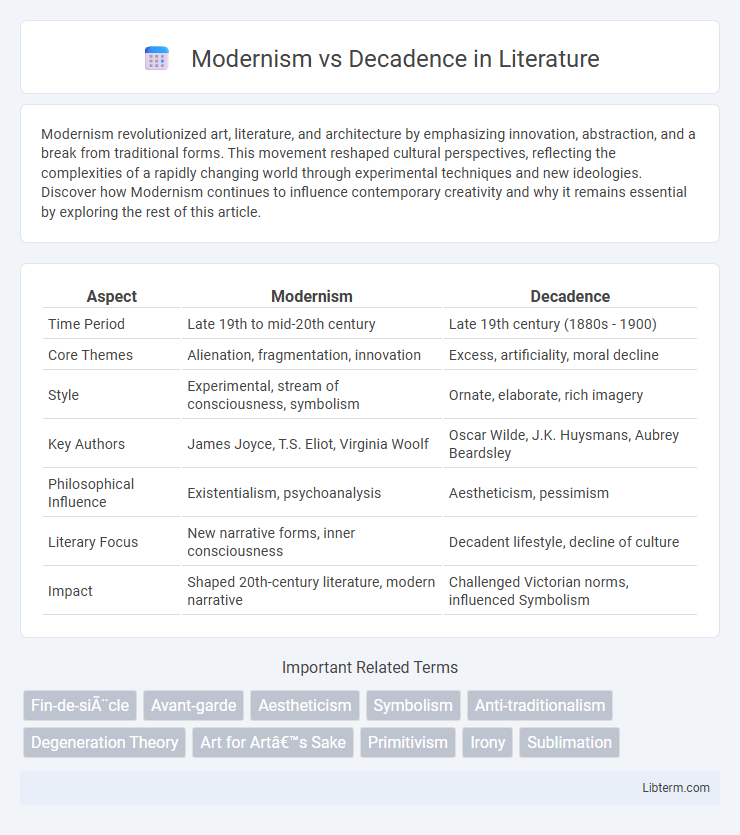Modernism revolutionized art, literature, and architecture by emphasizing innovation, abstraction, and a break from traditional forms. This movement reshaped cultural perspectives, reflecting the complexities of a rapidly changing world through experimental techniques and new ideologies. Discover how Modernism continues to influence contemporary creativity and why it remains essential by exploring the rest of this article.
Table of Comparison
| Aspect | Modernism | Decadence |
|---|---|---|
| Time Period | Late 19th to mid-20th century | Late 19th century (1880s - 1900) |
| Core Themes | Alienation, fragmentation, innovation | Excess, artificiality, moral decline |
| Style | Experimental, stream of consciousness, symbolism | Ornate, elaborate, rich imagery |
| Key Authors | James Joyce, T.S. Eliot, Virginia Woolf | Oscar Wilde, J.K. Huysmans, Aubrey Beardsley |
| Philosophical Influence | Existentialism, psychoanalysis | Aestheticism, pessimism |
| Literary Focus | New narrative forms, inner consciousness | Decadent lifestyle, decline of culture |
| Impact | Shaped 20th-century literature, modern narrative | Challenged Victorian norms, influenced Symbolism |
Defining Modernism: Origins and Key Principles
Modernism emerged in the late 19th and early 20th centuries as a radical departure from traditional forms, emphasizing innovation, abstraction, and a break with historical conventions. Influenced by rapid industrialization, World War I, and shifting social dynamics, key principles include a focus on subjective experience, fragmentation, and a quest for new artistic expressions to capture the complexities of modern life. Defining characteristics also involve experimentation with narrative structures and a rejection of the ornate aesthetics typical of Decadence, positioning Modernism as a forward-looking movement intent on redefining art, literature, and culture.
Understanding Decadence: Historical Roots and Meaning
Decadence emerged in the late 19th century as a cultural and artistic movement characterized by a fascination with excess, artificiality, and moral decline, reflecting societal anxieties during the fin de siecle period. Rooted in Symbolism and influenced by authors like Charles Baudelaire and Joris-Karl Huysmans, Decadence emphasized aestheticism, eroticism, and a rejection of conventional values. Understanding Decadence requires examining its opposition to Modernism's embrace of progress and innovation, as it instead dwelled on themes of decay and spiritual exhaustion.
Major Differences Between Modernism and Decadence
Modernism emphasizes innovation, abstraction, and a break from traditional forms, focusing on progress and new artistic expressions, while Decadence centers on aestheticism, decline, and the exploration of excess, often highlighting moral ambiguity and artifice. Modernist works frequently portray fragmented realities and a search for meaning in a rapidly changing world, whereas Decadent art indulges in sensuality, pessimism, and a fascination with decay. Key figures like T.S. Eliot and James Joyce epitomize Modernism's experimental style, contrasting with Decadent writers such as Oscar Wilde and J.K. Huysmans, who exemplify the movement's ornate and provocative themes.
Notable Figures: Influencers of Modernism and Decadence
Notable figures shaping Modernism include T.S. Eliot, Virginia Woolf, and James Joyce, whose innovative narratives and fragmented styles revolutionized 20th-century literature. In contrast, Decadence was epitomized by Charles Baudelaire, J.K. Huysmans, and Oscar Wilde, whose works emphasized aestheticism, moral ambiguity, and a fascination with decline and excess. These influencers expressed a profound reaction to traditional values, yet Modernism sought renewal and experimentation while Decadence embraced deterioration and artifice.
Literary Styles: Modernist Innovation vs Decadent Excess
Modernist innovation in literature emphasizes fragmented narratives, stream-of-consciousness techniques, and a break from traditional forms to explore psychological depth and social realities. Decadent excess is characterized by ornate, elaborate language, symbolism, and a preoccupation with artificiality, sensuality, and moral decline. Modernism seeks to redefine narrative structures and themes, whereas Decadence revels in indulgence and aesthetic extravagance.
Art and Aesthetics: Contrasting Visual Approaches
Modernism in art emphasizes abstraction, geometric forms, and a break from traditional representation, reflecting a pursuit of innovation and universal truths. Decadence, by contrast, embraces ornate detail, rich colors, and symbolic imagery, emphasizing sensuality, morbidity, and cultural decline. These visual approaches reveal Modernism's focus on progress and formal purity versus Decadence's indulgence in complexity and emotional excess.
Social and Cultural Impacts of Both Movements
Modernism challenged traditional social norms and cultural values by promoting innovation, individualism, and a break from historical constraints, influencing art, literature, and architecture with progressive ideals. Decadence, conversely, reflected social anxieties of its era through themes of decline, excess, and moral ambiguity, often critiquing industrialization and bourgeois society while emphasizing aestheticism and sensuality. Both movements reshaped cultural narratives: Modernism fostering a forward-looking optimism and experimentation, Decadence highlighting cultural disillusionment and the complexities of modern life.
Modernism and Decadence in Contemporary Culture
Modernism in contemporary culture emphasizes innovation, abstraction, and a break from traditional forms, fostering artistic experimentation and social progress. Decadence reflects a fascination with excess, aestheticism, and moral ambiguity, often highlighting themes of decline and hedonism in art and literature. The tension between these movements shapes current cultural expressions, balancing forward-thinking creativity with a critical exploration of cultural and moral boundaries.
Criticism and Legacy: Lasting Influence on Art and Thought
Modernism challenged Decadence by rejecting its ornate aesthetics and moral ambiguity, favoring innovation, abstraction, and social progress. Critics of Decadence condemned its perceived nihilism and excess, while Modernism's emphasis on experimentation influenced avant-garde movements across literature, visual arts, and architecture. The legacy of Modernism persists in contemporary art and critical theory, shaping discourses around subjectivity, form, and cultural critique.
Conclusion: The Ongoing Relevance of Modernism and Decadence
Modernism and Decadence continue to influence contemporary art and literature through their distinct approaches to innovation and cultural critique. Modernism's emphasis on breaking traditional forms and exploring subjective experience contrasts with Decadence's fascination with aesthetic excess and moral ambiguity, offering valuable insights into the complexities of modern identity. Their ongoing relevance is evident in today's creative practices, which blend experimental techniques with introspective themes to challenge societal norms.
Modernism Infographic

 libterm.com
libterm.com